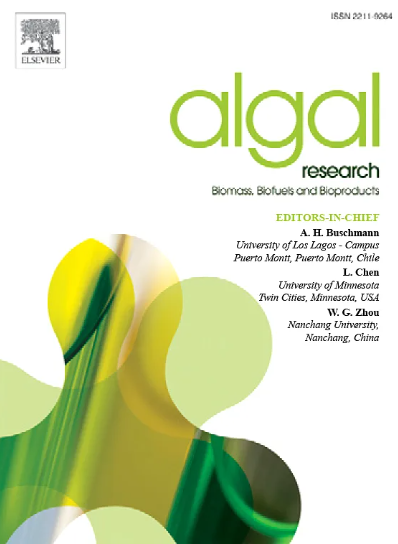通过多相法分离和鉴定栖息在印度 Shiv Kund(Sohna 温泉)的嗜热蓝藻:在不同氮环境中进行生物勘探,特别是生物燃料潜力方面的生物技术研究
IF 4.6
2区 生物学
Q1 BIOTECHNOLOGY & APPLIED MICROBIOLOGY
Algal Research-Biomass Biofuels and Bioproducts
Pub Date : 2024-10-21
DOI:10.1016/j.algal.2024.103757
引用次数: 0
摘要
在可再生能源需求不断攀升的时代,要实现藻类生物炼制的可持续发展,就必须找到具有最佳生长特性和高价值生物技术属性(尤其是生物燃料特性)的潜在候选藻类。对于嗜热蓝藻的工业潜力,目前还鲜有研究。为此,我们进行了一项初步研究,从印度古鲁格拉姆的 Shiv Kund、Sohna 温泉中分离出一种嗜热蓝藻。根据 NCBI-BLASTn 结果中 99.15 % 的相似度,通过 16SrRNA 分子鉴定和系统进化分析的多相方法确定分离出的嗜热蓝藻为 Fischerella thermalis PCC 7521。此外,在光学显微镜和扫描电子显微镜(SEM)下观察到的表型也证实了这是一种真分支丝状固氮蓝藻。为了从生物技术角度考察其潜力,研究了生长培养基中不同氮浓度对生化分析的影响。在硝酸钠浓度为 0.1875 g/L (N/8) 和 1.5 g/L (N) 时,生物量产量和生物量生产率最高,分别为 1041.6 mg/L 和 42.33 ± 1.52 mg/L/d⁎⁎(p < 0.01)。生长阶段对生化分析的影响也很显著,研究优化有助于以具有成本效益的方式生产所需的产品。令人惊讶的是,氮饥饿导致色素(叶绿素、藻蓝蛋白和类胡萝卜素)、蛋白质和脂质的产量增加。在生长周期的第 15 天,观察到碳水化合物产量最高的是在生长培养基完全供氮(N)的情况下,N 比完全缺氮(N0)的产量高出 37.4%。有趣的是,在生长周期的第 15 天和第 20 天,在 N0 条件下观察到的总脂产量分别为 457.41 ± 18.3 μg/mg ⁎(p ≤ 0.05)和 519.28 ± 21.3 μg/mg ⁎⁎(p < 0.01)。此外,还研究了氮浓度对碳/氮比和不同官能团的影响。总之,研究结果表明 F. thermalis PCC 7521 有希望用于不同的生物技术领域,尤其是生物燃料生产。本文章由计算机程序翻译,如有差异,请以英文原文为准。

Isolation and identification of thermophilic cyanobacterium inhabiting Shiv Kund (Sohna hot spring), India through polyphasic approach: Bioprospecting in varying nitrogen environment for biotechnological interest particularly for biofuel potential
Identifying a potential candidate having optimal growth characteristics and high-value biotechnological attributes, especially biofuel profile in the era of high rising renewable energy demands is necessary for a sustainable algal-biorefinery perspective. Thermophilic cyanobacteria are scarcely investigated for their industrial potential. In this regard, a preliminary study was performed to isolate a thermophilic cyanobacterium from Shiv Kund, Sohna hot spring, Gurugram, India. The polyphasic approach with molecular identification through 16SrRNA and phylogenetic analysis identified the isolated thermophilic cyanobacterium as Fischerella thermalis PCC 7521 based on the 99.15 % similarity in the NCBI-BLASTn results. Further, the phenotypic visualization under light microscopy and Scanning Electron Microscope (SEM) confirms the true-branching filamentous nitrogen fixing cyanobacterium. To examine its potential for a biotechnological perspective, the effect of different nitrogen concentrations in the growth medium on the biochemical profiling was studied. The highest biomass production and biomass productivity per day obtained was 1041.6 mg/L and 42.33 ± 1.52 mg/L/d⁎⁎(p < 0.01) in 0.1875 g/L (N/8) and 1.5 g/L (N) sodium nitrate concentration respectively. The effect of the growth phase on the biochemical profiling was also prominent and studying optimization helps in the cost-effective production of the required product. Surprisingly, nitrogen starvation has resulted in the increased production of pigments (chlorophyll, phycocyanin and carotenoids), proteins and lipids. The maximum carbohydrate production observed was under complete nitrogen availability (N) in the growth medium with 37.4 % more production in N than complete nitrogen starvation (N0) on 15th day of the growth cycle. Interestingly, the total lipid production observed was 457.41 ± 18.3 μg/mg ⁎(p ≤ 0.05) in N0 condition and 519.28 ± 21.3 μg/mg ⁎⁎(p < 0.01) in N/8 condition on 15th and 20th day of the growth cycle respectively. The effect of nitrogen concentrations on the C/N ratio and different functional groups were also examined. Overall, the results indicated F. thermalis PCC 7521 is a promising candidate for different biotechnological fields, especially biofuel production.
求助全文
通过发布文献求助,成功后即可免费获取论文全文。
去求助
来源期刊

Algal Research-Biomass Biofuels and Bioproducts
BIOTECHNOLOGY & APPLIED MICROBIOLOGY-
CiteScore
9.40
自引率
7.80%
发文量
332
期刊介绍:
Algal Research is an international phycology journal covering all areas of emerging technologies in algae biology, biomass production, cultivation, harvesting, extraction, bioproducts, biorefinery, engineering, and econometrics. Algae is defined to include cyanobacteria, microalgae, and protists and symbionts of interest in biotechnology. The journal publishes original research and reviews for the following scope: algal biology, including but not exclusive to: phylogeny, biodiversity, molecular traits, metabolic regulation, and genetic engineering, algal cultivation, e.g. phototrophic systems, heterotrophic systems, and mixotrophic systems, algal harvesting and extraction systems, biotechnology to convert algal biomass and components into biofuels and bioproducts, e.g., nutraceuticals, pharmaceuticals, animal feed, plastics, etc. algal products and their economic assessment
 求助内容:
求助内容: 应助结果提醒方式:
应助结果提醒方式:


